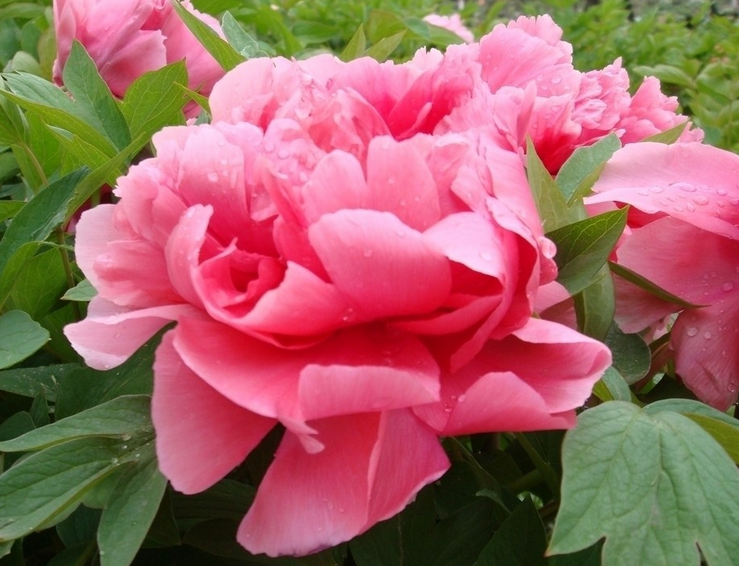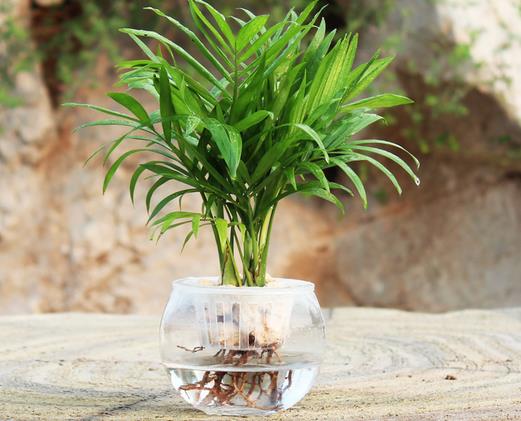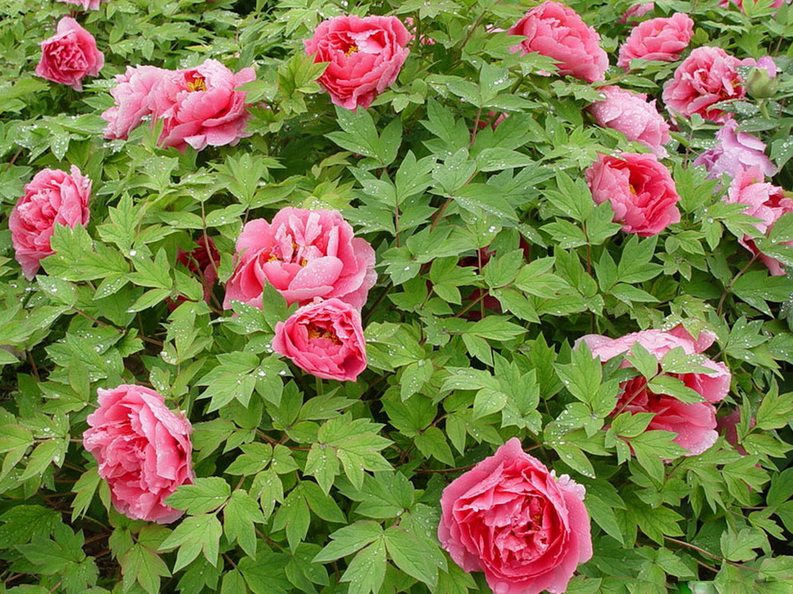Analysis on the Culture methods of off-season Peony enjoy the four Seasons
Peonies usually bloom in April or May every year, but through people's breeding, peonies can also be in full bloom in off-season. So what should be done when raising peonies out of season? Are there any methods, tricks and tricks? Next, let's learn more about it with the editor of the decoration network.

Analysis on the Culture methods of off-season Peony enjoy the four Seasons
Culture methods of off-season peony
First of all, the nutrients of the plants in out-of-season peonies come from the roots, the more roots, the stronger the roots, the more nutrients are available. Therefore, when selecting potted flowers, we should pay attention to the selection of peonies planted in larger and deeper pots under the condition of sturdy plants. It is best to have about 10 sturdy branches in a pot, most of the buds had better be in the early stage, and the leaves should be flat and strong.
Secondly, peony is a light-loving plant. Out-of-season peony is only to control light, temperature, moisture, etc., to create a suitable environment to promote its blossom on demand, but also to follow the attributes of light. In the budding period, it should be placed in a place with plenty of light. In full bloom, it can be placed in a place with scattered light. In this way, not fully developed buds will develop normally, buds will not be stiff buds, flowers are large, firm, strong and bright. The leaves are also flat and stout.
If there is curling, scorching and withering at the edge of the new leaves of peony, it may be that the temperature in the room is too high and the humidity is too low, so we should spray water to the leaves in time and relatively increase some air humidity. In addition, the potted flowers may be placed outdoors or indoor vents, directly hit by the cold wind in winter, resulting in frost damage. The way to prevent and cure it is to avoid the cold wind.
The best indoor temperature of out-of-season peony is above 10 ℃ in daytime and about 8 ℃ at night. Although this will make some exposed flowers bloom faster, it can also make some unexposed buds develop and blossom normally.
Because peony is a fleshy root system, out-of-season peony plants do not need to be too wet, it is necessary to keep the basin soil slightly dry. Water 250ml every 2-3 days or so. In addition, pay attention to timely removal of the buds on the side branches to ensure that there is only one flower at the top of each branch, and remove the basal sprouting and residual flowers at the same time.
Change the soil in time after blooming. Out-of-season peony basin soil is mostly pastoral soil or cinder mixed with fine soil, although smooth water, but no nutrients. To select a deep basin, fill the bottom of the basin with base fertilizer, and then use river sand and fertile pastoral soil 1 ∶ 3 mixed cultivation. If the root system is found to rot or die, it can be cut off and disinfected with 1% copper sulfate or carbendazim powder.
Finally, it should be noted that when spring comes, as long as the bud appears on the plant, it should be removed in time to avoid secondary flowering, and the plant consumes too much. After the out-of-season peony is bought home, the florescence of a single flower can reach 3-5 days, and the florescence of a single plant can reach 15-20 days.
Let's take a look at the management methods of out-of-season peony rejuvenation.
1. Refining seedlings after anthesis
The out-of-season peony after flower fade should remove the residual buds and reduce the consumption of nutrients. The method of gradually lowering the temperature, regular ventilation and gradually prolonging the ventilation time were adopted to enhance the ability of the plant to adapt to the external environment. Watering is based on the principle of "no dry, no watering, watering thoroughly", which should not only prevent water shortage, but also prevent rotting roots. Topdressing should be increased and foliar fertilizer should be sprayed.
2. Inverted basin transplantation
In April, with the increase of external temperature, the plant can gradually adapt to the external environment, at this time, the out-of-season peony should be poured out, the original plant can be planted in the ground, or it can be maintained in the pot, but the effect of planting on the ground is good. When transplanting, the branches and leaves of the plant should be pruned properly, the diseased and weak branches should be cut off, and 4-6 strong branches should be left in each plant, and 1-1 of the leaf quantity should be removed. At the same time, the diseased root and rotten root should be removed to promote the regeneration of new root and enhance the ability of water absorption, so as to alleviate the water balance between aboveground and underground. Apply sufficient base fertilizer when planting, and water thoroughly immediately after planting.
After that, the daily maintenance was carried out: according to the principle of "no dry, no watering, watering thoroughly", the plant was sprayed once a day on a sunny day, until before the rainy season, stagnant water was avoided in the rainy season, and fertilization was carried out in the form of foliar spraying and watering. Based on the principle of "a small number of times", the fertilizer concentration can be properly increased in the rainy season and foliar spraying about 10 days. Loosen the soil and weed in time during cultivation.
3. Shade over the summer
When rejuvenation cultivation, but because the plant is weak, we should pay attention to shading the peony when the summer weather is hot and the light is strong. Generally need about 50% of the daylight, at the same time, be sure to ensure good ventilation. At this time, water evaporation is very large, so watering should be timely, and after each watering, soil should be loosened, weeds should be removed, and attention should be paid to the prevention and control of diseases and insect pests. Soilless culture nutrient solution can be sprayed once a week, but remember not to topdressing. This is the key to this period.
4. Autumn and winter management
After the Beginning of Autumn, the temperature decreased gradually, Rain Water increased, and the root system of out-of-season peony grew rapidly. At this time, the concentration of fertilizer can be properly increased, based on the principle of "a small amount of fertilizer for many times", so that the root system can grow rapidly and healthily, and the foliar fertilizer can be sprayed once every 10 days until the leaves fall. In mid-late September, the shade net can be removed. Increase the application of compound fertilizer before winter. Pay attention to cold and cold resistance in winter.
5. Rejuvenation management in the second year
After one year of maintenance and rejuvenation management, by the spring of the second year, the growth potential of the plant had gradually recovered. After the weather warms up in spring, apply quick-acting fertilizer. Foliar fertilizer spraying should be carried out after leaf spreading, a small amount of fertilizer should be applied many times, and thin fertilizer should be applied frequently, once every 10 days, until before defoliation. At the same time, root topdressing should be carried out once a month. After a year of fine cultivation of out-of-season peony, buds have been seen on some plants. in order to fully restore their growth potential, the buds should be completely removed. Attention should also be paid to the prevention and control of peony diseases and insect pests.
An Analysis of the Culture methods of Mulberry Leaf Peony to teach you to cultivate Mulberry Leaf Peony easily
Mulberry leaf peony is a famous flower in China, with large flowers and many colors, although it is ridiculed in the morning, but it is continuous, with a long flowering period and the most prosperous summer and autumn flowers, which is deeply loved by people. many people want to raise mulberry leaf peonies themselves, but they do not know how to raise them. Next, let's learn more about it with the editor of the decoration network.
An Analysis of the Culture methods of Mulberry Leaf Peony to teach you to cultivate Mulberry Leaf Peony easily
Culture methods of Mulberry Leaf Peony
1. Because mulberry leaf peony is a positive flower, it should be placed in the place where the sunshine is long, so that it can be fully exposed to sunlight in summer, and the lack of light can easily make the flower bud fall, the flower becomes smaller and the flower color is dim.
2. Too dry and wet will affect flowering. In the summer blooming season, depending on the air temperature and the dry and wet condition of the basin soil, water can be watered once or twice a day, but dry and thoroughly irrigated to prevent rotting roots due to high temperature and stagnant water. Watering is better before 9: 00 a. M. or after 5: 00 p. M. to minimize the temperature difference between air temperature and water temperature. At noon, water can be sprayed on the leaf surface and around the flowerpot to reduce the leaf temperature and maintain air humidity. The flowers of Fusang are very tender and cannot be sprayed directly to the flowers, otherwise they can easily cause burns.
3. Change the basin every year, use rotten bean cake and poultry dung as base fertilizer, and then apply well-absorbed and effective compound fertilizer. 0% potassium dihydrogen phosphate can be sprayed to the leaves every 7-10 days to make the leaves green and breed more buds.
4. Fusang is not resistant to cold, so whether it can survive the winter safely is the key. The winter temperature should be kept at 12-15 ℃, and it is easy to freeze to death if it is lower than 5 ℃. However, it should be noted that the temperature should not exceed 20 ℃. Too high temperature will cause branches and leaves to grow, affect dormancy, and blossom in the coming year. The basin soil should maintain 30% relative humidity in winter and should not be watered in large quantities. It is generally not necessary to apply fertilizer in winter, and only a small amount of liquid fertilizer is needed.
5. Pruning should be carried out in spring, leaving stout branches to ensure the concentration of nutrients and the blooming of flowers.
Propagation methods of Mulberry Leaf Peony
1. Mulberry leaf peony cutting
Cutting is the most commonly used method of mulberry leaf peony propagation, which can be cut at any time from early spring to late autumn, with the highest survival rate in the rainy season and can only be carried out in the greenhouse in winter. The best cuttings are one-and-a-half Lignification, about 10 cm long, cut off the lower leaves, leave the top leaves, cut flat, insert in the sand bed, spray water every day to maintain high air humidity. It takes root three weeks after insertion and can be put on the pot after 45 days of growth. Generally speaking, the mulberry leaf peony cut in that year can blossom in the second year.
2. High pressure propagation of mulberry leaf peony.
It is mainly aimed at the woody branches, which are more commonly used in woody plant species. Mulberry leaf peony can also give it a try. It is safer than cutting high-pressure propagation, at least it will not die. Haha, the following is a high-pressure sample diagram. The picture is not mulberry leaf peony.
3. Striping propagation
This is also very simple, that is, press the branches of mulberry leaf peony in the soil, let them take root, and cut off after taking root, the principle is similar to high pressure, but there are slight differences according to the actual situation. These three methods are very simple and operable. Flower friends can give it a try.
Analysis of Culture methods of Mulberry Leaf Peony
Mulberry leaf peony is a famous flower in China, with large flowers and many colors. Although it is ridiculed in the morning, it goes on and on, with a long flowering period and the most blooming summer and autumn flowers. Many people want to raise mulberry leaf peonies on their own. The following is to learn more about the cultivation methods of mulberry leaf peony with the editor of the decoration network.
Analysis of Culture methods of Mulberry Leaf Peony
Culture methods of Mulberry Leaf Peony
1. Because mulberry leaf peony is a positive flower, it should be placed in the place where the sunshine is long, so that it can be fully exposed to sunlight in summer, and the lack of light can easily make the flower bud fall, the flower becomes smaller and the flower color is dim.
2. Too dry and wet will affect flowering. In the summer blooming season, depending on the air temperature and the dry and wet condition of the basin soil, water can be watered once or twice a day, but dry and thoroughly irrigated to prevent rotting roots due to high temperature and stagnant water. Watering is better before 9: 00 a. M. or after 5: 00 p. M. to minimize the temperature difference between air temperature and water temperature. At noon, water can be sprayed on the leaf surface and around the flowerpot to reduce the leaf temperature and maintain air humidity. The flowers of Fusang are very tender and cannot be sprayed directly to the flowers, otherwise they can easily cause burns.
3. Change the basin every year, use rotten bean cake and poultry dung as base fertilizer, and then apply well-absorbed and effective compound fertilizer. 0% potassium dihydrogen phosphate can be sprayed to the leaves every 7-10 days to make the leaves green and breed more buds.
4. Fusang is not resistant to cold, so whether it can survive the winter safely is the key. The winter temperature should be kept at 12-15 ℃, and it is easy to freeze to death if it is lower than 5 ℃. However, it should be noted that the temperature should not exceed 20 ℃. Too high temperature will cause branches and leaves to grow, affect dormancy, and blossom in the coming year. The basin soil should maintain 30% relative humidity in winter and should not be watered in large quantities. It is generally not necessary to apply fertilizer in winter, and only a small amount of liquid fertilizer is needed.
5. Pruning should be carried out in spring, leaving stout branches to ensure the concentration of nutrients and the blooming of flowers.
Propagation methods of Mulberry Leaf Peony
1. Mulberry leaf peony cutting
Cutting is the most commonly used method of mulberry leaf peony propagation, which can be cut at any time from early spring to late autumn, with the highest survival rate in the rainy season and can only be carried out in the greenhouse in winter. The best cuttings are one-and-a-half Lignification, about 10 cm long, cut off the lower leaves, leave the top leaves, cut flat, insert in the sand bed, spray water every day to maintain high air humidity. It takes root three weeks after insertion and can be put on the pot after 45 days of growth. Generally speaking, the mulberry leaf peony cut in that year can blossom in the second year.
2. High pressure propagation of mulberry leaf peony.
It is mainly aimed at the woody branches, which are more commonly used in woody plant species. Mulberry leaf peony can also give it a try. It is safer than cutting high-pressure propagation, at least it will not die. Haha, the following is a high-pressure sample diagram. The picture is not mulberry leaf peony.
3. Striping propagation
This is also very simple, that is, press the branches of mulberry leaf peony in the soil, let them take root, and cut off after taking root, the principle is similar to high pressure, but there are slight differences according to the actual situation. These three methods are very simple and operable. Flower friends can give it a try.
- Prev

What are the advantages of hydrophytes? What are the two main types of aquatic plants?
What are the advantages of hydrophytes? First, because water can evaporate freely, in the same environment, plants grown in pots have a more obvious role in regulating air humidity than plants grown in pots. Second, water plants can omit the management of pot soil, clean and sanitary, simple maintenance. third
- Next

The prevention and control of peony diseases and pests can help you cultivate peony flowers easily.
In the process of peony culture, peony flowers are often attacked by diseases and insect pests due to improper culture and other reasons. So the editor of the decoration network reminds you that when raising peonies, you must first master some relevant knowledge.
Related
- Fuxing push coffee new agricultural production and marketing class: lack of small-scale processing plants
- Jujube rice field leisure farm deep ploughing Yilan for five years to create a space for organic food and play
- Nongyu Farm-A trial of organic papaya for brave women with advanced technology
- Four points for attention in the prevention and control of diseases and insect pests of edible fungi
- How to add nutrient solution to Edible Fungi
- Is there any good way to control edible fungus mites?
- Open Inoculation Technology of Edible Fungi
- Is there any clever way to use fertilizer for edible fungus in winter?
- What agents are used to kill the pathogens of edible fungi in the mushroom shed?
- Rapid drying of Edible Fungi

